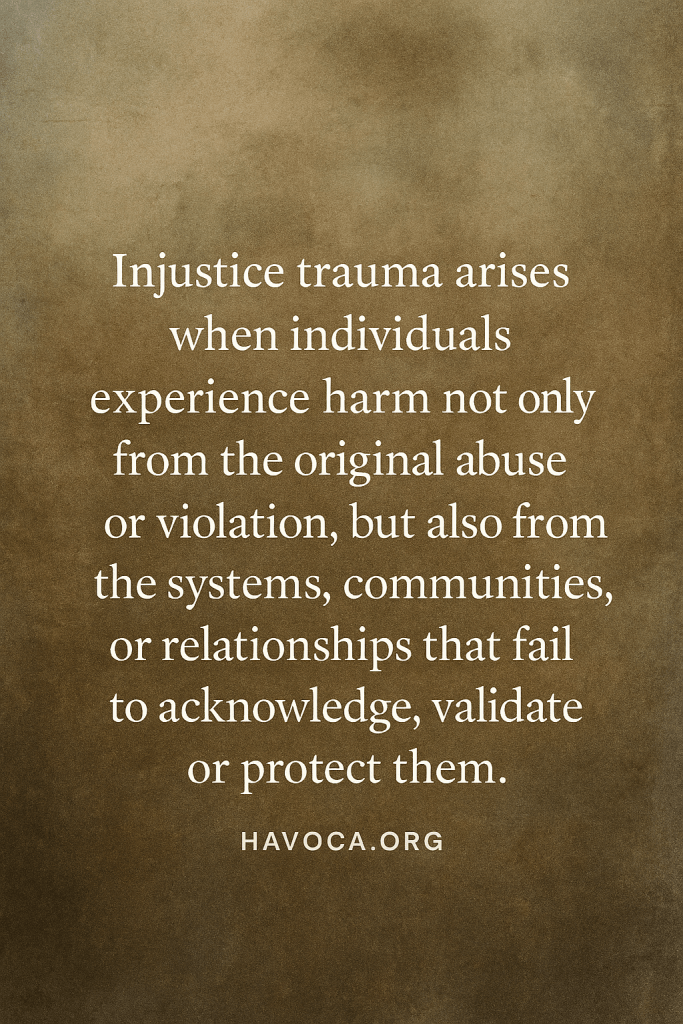 Injustice Trauma: When the Scales Tip Against Us
Injustice Trauma: When the Scales Tip Against Us
Understanding Injustice Trauma
Injustice trauma arises when individuals experience harm not only from the original abuse or violation, but also from the systems, communities, or relationships that fail to acknowledge, validate, or protect them. Survivors often describe this as a “second wound”—the pain of being silenced, disbelieved, or dismissed after already enduring profound suffering.
The first wound is the abuse, neglect, or violation itself. The second wound is the betrayal of trust when institutions, families, or society minimize or deny the survivor’s experience. The lasting impact is feelings of rage, helplessness, and alienation that can linger long after the original trauma.
I have been exploring this in therapy recently, and it has helped me to see how much of my pain comes not only from what happened, but also from the way others responded—or failed to respond. Naming this as injustice trauma has given me language for something I had long felt but couldn’t quite articulate.
How Injustice Trauma Manifests
Survivors may find themselves grappling with emotions that feel disproportionate or confusing. Yet these responses are deeply human reactions to systemic betrayal.
- Anger: a natural response to being wronged, often intensified when justice is denied.
- Shame: internalized when survivors are blamed or disbelieved.
- Isolation: withdrawing from communities that failed to protect or support them.
- Distrust: difficulty believing in fairness, authority, or relationships.
The Social Dimension
Injustice trauma is not just personal—it’s collective. When society fails to hold perpetrators accountable, survivors carry the burden of injustice alone. This perpetuates cycles of silence and stigma.
- Legal systems: lengthy trials, dismissals, or lack of evidence can retraumatize survivors.
- Communities: gossip, disbelief, or minimization can deepen wounds.
- Cultural narratives: myths about abuse often shift blame onto survivors instead of perpetrators.
Pathways Toward Healing
Healing from injustice trauma requires more than personal resilience—it calls for collective acknowledgment and systemic change. Survivors often find strength in reclaiming their voice and connecting with others who understand.
- Validation: being heard and believed is a powerful antidote to injustice.
- Community support: survivor networks like HAVOCA provide solidarity and understanding.
- Advocacy: pushing for systemic change can transform anger into purposeful action.
- Self-compassion: recognizing that the injustice is not the survivor’s fault.
Closing Thoughts
Injustice trauma reminds us that healing is not only about recovering from what happened, but also about confronting the ways society responds to survivors. Every voice that speaks out chips away at silence. Every act of solidarity restores balance to the scales of justice.
Recommended Reading on Injustice Trauma and Healing
The Body Keeps the Score by Bessel van der Kolk A foundational book on how trauma affects the brain and body, and how survivors can heal through therapy, movement, and connection.
The Deepest Well by Nadine Burke Harris Shows how childhood adversity leads to long-term health issues and how systemic neglect compounds trauma.
It Wasn’t Your Fault by Beverly Engel A compassionate guide for survivors struggling with shame and self-blame.
What Happened to You? by Oprah Winfrey and Dr. Bruce Perry A trauma-informed approach that shifts the lens from “What’s wrong with you?” to “What happened to you?”
Complex PTSD: From Surviving to Thriving by Pete Walker Offers practical tools for survivors of prolonged abuse, especially when justice or support was absent.



